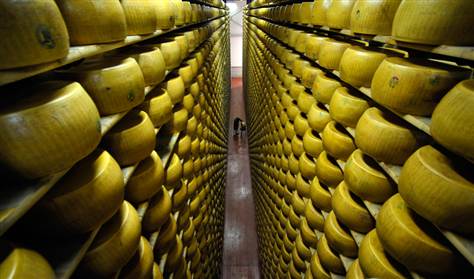Cheese You Can Bank On

(It’s just under 4 minutes long and it’s funnier than the story below.)
The complex world of high finance can be daunting for many — banks can get very creative when it comes to loans, securities, and other financial instruments. At times, these creative endeavors can lead to disaster — take the 2008 economic crash and its much-talked-about “credit default swaps” and “collateralized debt obligations” — but that need not be the case. In fact, sometimes these interesting banking maneuvers can be quite good. Tasty, even.

Pictured above is a picture of the inside of a vault at an Italian bank called Credito Emiliano, or Credem for short (via NBC News). The vault, like most other bank vaults, has high-end security — cameras, electronic doors, around the clock security, etc. This one, though, pays particular attention to the vault’s temperature and humidity as well. That’s because the items on the shelves of that vault aren’t cash, gold, or gemstones — they’re 80-pound wheels of cheese.
Parmesan, specifically.
If you’re a Parmesan producer, there’s a good chance you have a cash flow problem. In the short term, you need to pay your employees and feed your cows, but you don’t end up with a revenue-generating product right away. As Harvard Business School professor Nikolaos Trichakis explained, Parmesan producers “face very long lead times,” as a good quality cheese requires at least 18 months (and ideally, up to 36 months) to age to maturity. Per Trichakis, the producers “basically have working capital tied to inventory for two years. They could shorten the maturation to cut down on costs, but then the cheese that we eat would not be as tasty.” And less-tasty cheese means less demand, and therefore lower cheese prices.
Enter Credem. Since 1953, the bank has been offering a cheese-secured loan to area Parmesan producers. The terms are pretty straightforward. The bank gives the cheesemakers a loan equal to 60-80% of the cheese’s value at a reasonable interest rate (about 3% as of 2009, per the BBC). As collateral, the cheesemakers store their cheese in Credem’s special vault/warehouse. If the Parmesan owner defaults on the loan, Credem keeps the cheese and sells it when it’s ready. And it helps that the cheese gets better with age anyway — while sitting in Credem’s vault, the value of the collateral keeps appreciating. Ultimately, these 80-pound cheese wheels have a wholesale price of about 300 Euro (about $350 dollars), as of 2009, per NBC News. The loan is a rather low-risk win for all involved.
And not only does Credem keep the cheese maturing, but the bank also keeps it safe — usually. According to the New York Times, “each wheel [ . . . ] is branded with a serial number so it can be traced if it is stolen” — something which has happened a few times in the past. For example, the Times notes, “thieves tunneled into one warehouse in February [of 2009] and made off with 570 pieces before they were apprehended by the police.” (Joked one warehouse manager, “thank heavens we caught the robbers before they grated it.”)
If you think a 570-wheel heist is a lot of cheese, it’s nothing compared to what Credem has in its vault — in total, the bank houses nearly half a million wheels of cheese at any given point in time. To give an idea as to how much that is, check out this photo from ABC News Australia — it shows only about 1,000 of the wheels, so multiply that by 500. And be thankful that all that cheese is there, because, without the Parmesan banking system, it would be hard for many of the producers to stay in business.
Bonus fact: Parmesan cheese contains a significant amount of a compound called butyric acid, which, coincidentally, is what gives human vomit its “distinctive smell,” per Wikipedia. Or, perhaps, that smell isn’t so distinctive. According to the book “Proust Was a Neuroscientist,” if you place both parmesan and puke in front of a blindfolded person, and ask them to take a big whiff, there’s a good chance the person will have a hard time telling the two smells apart.
From the Archives: This Cheese Stands Alone: The story behind a really expensive type of cheese, costing as much as $500 per pound.
Take the Quiz: Can you pick the 20 cheeses without picking one of the 3 crackers?
Related: A pound of Parmesan, aged three years. About $20.
